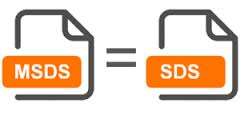By Guest Blogger: Lisa Stringfellow of Graphic Products
On December 1, 2013—about one year from now—the implementation of training to the new Hazard Communication Standard (29 CFR 1910.1200) will be required. This includes changes in the way hazards of chemicals are conveyed. One key aspect of this change is the replacement of MSDSs (Material Safety Data Sheets) with SDSs (Safety Data Sheets). The changes are designed to simplify communication regarding hazardous materials and promote international consistency.
new Hazard Communication Standard (29 CFR 1910.1200) will be required. This includes changes in the way hazards of chemicals are conveyed. One key aspect of this change is the replacement of MSDSs (Material Safety Data Sheets) with SDSs (Safety Data Sheets). The changes are designed to simplify communication regarding hazardous materials and promote international consistency.
What’s the difference between MSDS and SDS?
MSDSs are lengthy documents that accompany hazardous chemicals. They indicate all the dangers associated with the material, as well as instructions regarding handling, storage and disposal. MSDSs are a key aspect of the Right-to-Know provision of OSHA’s Hazard Communication Standard. The standard being phased out allowed for several formats for an MSDS, including an OSHA version with eight sections and an ANSI version with 16 sections. OSHA’s HazCom 2012, based on the GHS standard, requires GHS’s own 16-section version. The “M” in MSDS is being dropped as well. So in short, the name is being simplified, and the format is being standardized.
The 16 sections in an SDS are required in the following order:
- Identification: Product identifier; manufacturer or distributor name, address, phone number; emergency phone number; recommended use; restrictions on use.
- Hazard(s) identification: All hazards regarding the chemical; required label elements.
- Composition/information on ingredients: Information on chemical ingredients; trade secret claims.
- First-aid measures: Important symptoms/effects, acute, delayed; required treatment.
- Fire-fighting measures: Suitable extinguishing techniques, equipment; chemical hazards from fire.
- Accidental release measures: Emergency procedures; protective equipment; proper methods of containment and cleanup.
- Handling and storage: Precautions for safe handling and storage, including incompatibilities.
- Exposure controls/personal protection: OSHA’s Permissible Exposure Limits (PELs); Threshold Limit Values (TLVs); appropriate engineering controls; personal protective equipment (PPE).
- Physical and chemical properties: List of the chemical’s characteristics.
- Stability and reactivity: Chemical stability and possibility of hazardous reactions.
- Toxicological information: Routes of exposure; related symptoms, acute and chronic effects; numerical measures of toxicity.
- Ecological information*
- Disposal considerations*
- Transport information*
- Regulatory information*
- Other information: Includes the date of preparation or last revision and any other pertinent information.
*Note: OSHA won’t enforce Sections 12 through 15 because they fall under the regulatory authority of other agencies.
Need more information on the difference between MSDS and SDS or other expected changes from the Hazard Communication Standard see OSHA’s Fact Sheet on the Hazard Communication Standard or leave a comment below.

